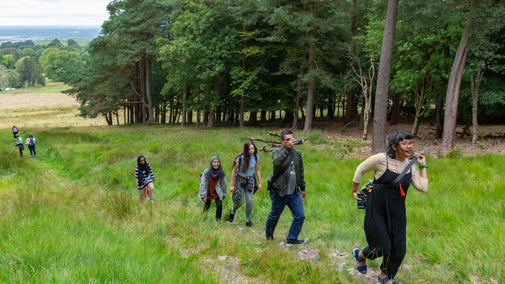Views of the Hughenden Manor estate walk
Oxfordshire, Buckinghamshire & Berkshire
This is a circular 5.3 mile (8.6 km) walk around the Hughenden Manor estate which gives you 10 different views of the surrounding Chilterns countryside.
Near to
HughendenStart point
Start at the visitor welcome kiosk. Grid Ref SU860955Trail information
*Mainly on soft footpaths, with short, but fairly steep ascents and descents, which may be muddy and slippery after rain. There are gates and road crossings. For further details, please see Terrain section.
**No stiles but a number of gates, and several short, but fairly steep ascents and descents. For further details, please see section marked Access.
***Dogs can be off-lead around the woodland and parkland. Please put them on a lead in areas with cattle and sheep. For further details, please see section marked Facilities.
Following the walk
This walk is not waymarked but you can follow it on a hand-held device or print out a copy to use as you walk. Parts of the route between points 7 and 10 are not on National Trust land, and the National Trust does not check for hazards on these sections of the walk. You therefore follow this route at your own risk.
More near here
Hughenden's Monument walk
Discover a short 2-mile return walk with moderate hill climbs that takes in the monument at Hughenden. Take in far-reaching views from the monument which is known to be is one of the best look-out points the area.

Boundary walk at Hughenden
Explore beautiful woodland, open parkland, farmland and a rare chalk stream on this energetic 4-mile circular walk that runs close to the estate boundary.

German Forest walk at Hughenden
This 1.5-mile walk at Hughenden, Buckinghamshire, explores the evergreen woods inspired by Disraeli's visits to the Northern Bohemian forests.

Get in touch
Our partners

We’ve partnered with Cotswold Outdoor to help everyone make the most of their time outdoors in the places we care for.
You might also be interested in
Staying safe at National Trust places
The special places in National Trust care sometimes come with a few risks for visitors, be it coastline or countryside. Find out how to keep safe throughout your visits.

Walking in Oxfordshire, Buckinghamshire and Berkshire
From gentle strolls for little legs to longer hikes through the rolling Chiltern hills, these are some of the best walks in Oxfordshire, Buckinghamshire and Berkshire.

Walking
Explore some of the finest landscapes in our care on coastal paths, accessible trails, woodland walks and everything in between. Find the best places to walk near you.

Follow the Countryside Code
Help to look after National Trust places by observing a few simple guidelines during your visit and following the Countryside Code.

Cotswold Outdoor: our exclusive walking partner
Learn about the National Trust’s ongoing partnership with Cotswold Outdoor. Find out how they help us care for precious places and the exclusive discount available for National Trust supporters.


